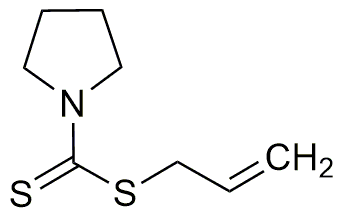Allyl 1-pyrrolidinecarbodithioate is widely utilized in research focused on:
- Agrochemicals: This compound is used as a pesticide and fungicide, providing effective protection for crops against pests and diseases, which is essential for sustainable agriculture.
- Polymer Chemistry: It serves as a reactive additive in the formulation of polymers, enhancing their properties such as flexibility and durability, making it valuable in the production of high-performance materials.
- Pharmaceuticals: The compound is explored for its potential in drug development, particularly in creating new therapeutic agents that can target specific biological pathways.
- Flavor and Fragrance Industry: It is used as a flavoring agent, contributing to the development of unique taste profiles in food products, which can enhance consumer appeal.
- Research Applications: Allyl 1-pyrrolidinecarbodithioate is employed in various chemical syntheses and reactions, aiding researchers in developing new compounds and understanding reaction mechanisms.
General Information
Properties
Safety and Regulations
Applications
Allyl 1-pyrrolidinecarbodithioate is widely utilized in research focused on:
- Agrochemicals: This compound is used as a pesticide and fungicide, providing effective protection for crops against pests and diseases, which is essential for sustainable agriculture.
- Polymer Chemistry: It serves as a reactive additive in the formulation of polymers, enhancing their properties such as flexibility and durability, making it valuable in the production of high-performance materials.
- Pharmaceuticals: The compound is explored for its potential in drug development, particularly in creating new therapeutic agents that can target specific biological pathways.
- Flavor and Fragrance Industry: It is used as a flavoring agent, contributing to the development of unique taste profiles in food products, which can enhance consumer appeal.
- Research Applications: Allyl 1-pyrrolidinecarbodithioate is employed in various chemical syntheses and reactions, aiding researchers in developing new compounds and understanding reaction mechanisms.
Documents
Safety Data Sheets (SDS)
The SDS provides comprehensive safety information on handling, storage, and disposal of the product.
Product Specification (PS)
The PS provides a comprehensive breakdown of the product’s properties, including chemical composition, physical state, purity, and storage requirements. It also details acceptable quality ranges and the product's intended applications.
Certificates of Analysis (COA)
Search for Certificates of Analysis (COA) by entering the products Lot Number. Lot and Batch Numbers can be found on a product’s label following the words ‘Lot’ or ‘Batch’.
*Catalog Number
*Lot Number
Certificates Of Origin (COO)
This COO confirms the country where the product was manufactured, and also details the materials and components used in it and whether it is derived from natural, synthetic, or other specific sources. This certificate may be required for customs, trade, and regulatory compliance.
*Catalog Number
*Lot Number
Safety Data Sheets (SDS)
The SDS provides comprehensive safety information on handling, storage, and disposal of the product.
DownloadProduct Specification (PS)
The PS provides a comprehensive breakdown of the product’s properties, including chemical composition, physical state, purity, and storage requirements. It also details acceptable quality ranges and the product's intended applications.
DownloadCertificates of Analysis (COA)
Search for Certificates of Analysis (COA) by entering the products Lot Number. Lot and Batch Numbers can be found on a product’s label following the words ‘Lot’ or ‘Batch’.
*Catalog Number
*Lot Number
Certificates Of Origin (COO)
This COO confirms the country where the product was manufactured, and also details the materials and components used in it and whether it is derived from natural, synthetic, or other specific sources. This certificate may be required for customs, trade, and regulatory compliance.


